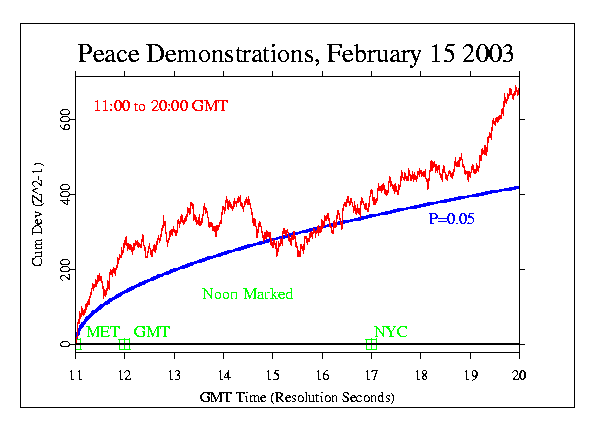Peace Demonstrations Feb 15 2003 |
|
There is a building cascade of urgent efforts to do things that may help to prevent the planned preemptive US war on Iraq. There are many pro-peace demonstations scheduled for the weekend of February 15. One of the lists that sends things to me describes the horrors that await if we do not succeed in halting the imminent war on Iraq, and then urges participation in rallies as a way of doing something to help:
The GCP made a formal prediction that the 15th would show departures from expectation in the standard analysis. The original thought was to signal average major time-blocks in Europe and US, and if indicated, in the other capitols. The rallies were expected to continue for periods of 3 hours or more from the time set for assembly. On the 15th, before looking at any data, it became clear from news reports that millions were engaged, in hundreds of cities around the world. So the prediction was simplified to accomodate all the major demonstrations from Tokyo to San Francisco by specifying the prediction for the whole day. We also specified that we would look at other periods to test (informally) the expectation that there might be greater effect in the times of the biggest, most intense demos, such as Berlin, London, and New York. In Berlin, the beginning was noon, and concluding speeches were expected between 14:00 and 16:00. London and New York also assembled at noon, other places at different times, e.g., Paris at 14:00. Our formal prediction was in any case for the whole GMT day, applying the standard analysis. Secondary predictions identified the European US focus, to include Berlin, Paris, London, and New York and other US locations. A set of independent analyses has been done by Bryan Williams. These look at the same time periods, but use blocked data, and provide a valuable perspective. The first figure shows the formal result, which has fairly normal looking random walk for the first part of the day, but a striking trend beginning about the time the major European demonstrations got under way. The chisquare is 87135 on 86400 df, with p = 0.039.
The second graph shows the secondary analysis covering the period from 11:00 GMT to 20:00 GMT. It coincides with the strongest trend during the day, and so has a more striking appearance. If it were formal, the statistics would be impressive: chisquare = 33094 on 32400 df, and p = 0.0034.
Note: Egg 231 had a failure shortly after 11:00 GMT, and produced bad data. It was removed from the array. |

